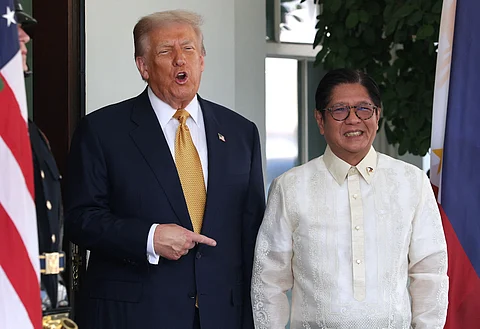
- NEWS
- the EDIT
- COMMENTARY
- BUSINESS
- LIFE
- SHOW
- ACTION
- GLOBAL GOALS
- SNAPS
- DYARYO TIRADA
- MORE

WASHINGTON, D.C. — US President Donald Trump on Tuesday announced a 19-percent tariff on Philippine goods entering the United States — a very slight reduction from the previously recommended 20 percent.
“The Philippines is going open market with the United States, and zero tariffs. The Philippines will pay a 19-percent tariff,” Trump announced in a post on Truth Social following his first bilateral meeting with President Ferdinand Marcos Jr. at the White House.
“In addition, we will work together militarily,” he added.
Trump said it was a great honor to be with Marcos. “He is highly respected in his country, as he should be. He is also a very good, and tough, negotiator.”
Marcos: Significant achievement
The trade deal puts the Philippines at a disadvantage, as certain big-ticket items such as automobiles can now enter the Philippine market tariff-free.
“Now, I think it’s, I can already tell everyone, as it’s come out already, that we managed to bring down the 20-percent tariff rate for the Philippines to 19,” Marcos told Filipino journalists in the Garden Room of Blair House where he is staying.
“Now, one percent might seem like a very small concession. However, when you put it into real terms, it is a significant achievement. So, we have a 19-percent rate coming from imports from the Philippines into the United States,” he said.
Marcos said the one-percentage point reduction was “because of the special relationship” between the Philippines and the United States.
The reduction, however, was modest compared to what the Philippines’ neighbors got.
Indonesia, for example, secured a decrease from 32 percent to 19 percent for certain sectors. Cambodia was able to lower its tariff by 13 percentage points, while Laos received an 8-point cut.
Trump had originally imposed a 17-percent tariff on Philippine goods entering the US in April.
Open market
Marcos, whom Trump praised as being a “tough negotiator,” confirmed the latter had asked that certain markets be opened.
“The one, the major areas that he said were automobiles. Because we have a tariff on American automobiles, we will open that market and no longer charge tariffs on that. So, there are several,” he said.
Marcos said that Trump agreed to boost exports of American-made soy and wheat products, along with an increase in medicine shipments.
“We are coming to those arrangements. There are still a lot of details that need to be worked out on the different products and the different exports and imports,” he said.
“But basically, that’s now our template. That’s what we are following, at a 19-percent tariff rate on Philippine goods that are imported into the United States,” he added.
‘We tried’
Marcos said he “tried very hard” to negotiate a lower tariff for Filipino products but acknowledged that “this is how negotiations go.”
“We came here. When we arrived in Washington, the tariff rate was at 20. Why it went up from 17 to 20 is an internal matter with the United States government,” he said when asked if the trade deal was unfavorable to the country.
“We, but the number that we had to work with was 20. We tried very hard to see what we could do. And we managed the one percent decrease in tariff rates,” he said.
Trump earlier cited a deficit of nearly $5 billion with the Philippines last year on bilateral goods trade of $23.5 billion as the basis for the new tariff rate for its treaty ally.
The Philippines is one of the oldest allies of the United States in the Indo-Pacific region.
Immigration not on table
Marcos said his bilateral meeting with Trump did not include any discussions on US immigration policies.
He noted that the Trump administration’s stance on illegal immigrants was “not anything different from what they had been doing before.”
However, there have been reports of American citizens of Filipino descent arrested by United States Immigration and Customs Enforcement (ICE).
A document dated November 2024 showed that a total of 3,772 Filipinos were classified as “noncitizens” on ICE’s Enforcement and Removal Operations’ non-detained docket with final orders of removal.
According to the Department of Foreign Affairs, an estimated 370,000 undocumented Filipinos are living in the US.
